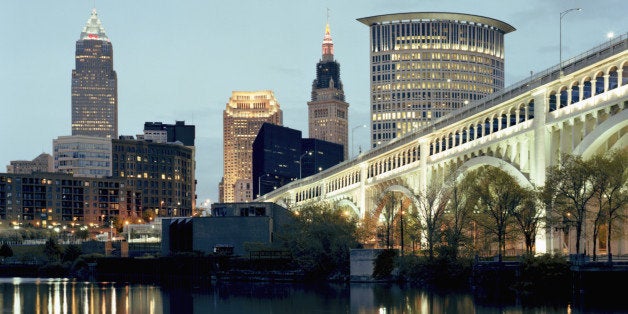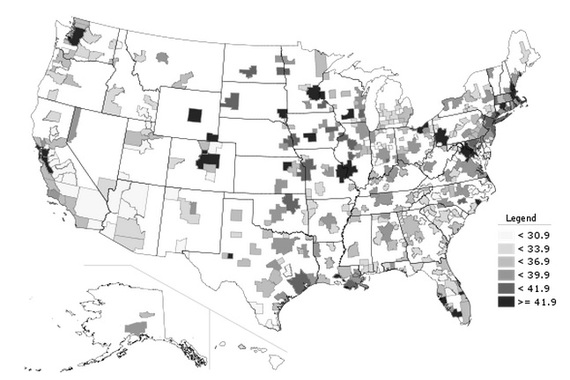
Recently, news broke that the site selection for the 2016 GOP national convention is down to two cities: Cleveland and Dallas. At first blush, the finalists are an odd pairing, pitting a region labeled with "post-industrial decline" against one labeled with "boomtown growth."
Is Cleveland a sympathy case? There to be recognized by site selection king makers in a token "there, there" fashion while Dallas inevitably gets top bill? Or do the power brokers see something else? Namely, a re-emerging region long on resilience if not accolades.
Put another way, is the stubborn "Rust Belt is dead" stereotype finally dying off?
When a people fall from grace, the sentiment of decline tends to stick. The Rust Belt's demise is cemented, regardless of positive, if slow-moving, realities on the ground. These slow-moving realities are termed "mesofacts," and they are facts that change so slow that they are often overlooked.
"We recognize rapid change," notes complex system scientist Samuel Arbesman, who coined the term. "But anything short of large-scale rapid change is often ignored." In an op-ed for the Boston Globe, Arbesman uses Pittsburgh as a place fighting mesofacts in the re-writing of its narrative:
"[I]magine you are considering relocating to another city. Not recognizing the slow change in the economic fortunes of various metropolitan areas, you immediately dismiss certain cities. For example, Pittsburgh, a city in the core of the historic Rust Belt of the United States, was for a long time considered to be something of a city to avoid. But recently, its economic fortunes have changed, swapping steel mills for technology, with its job growth ranked sixth in the entire United States."
Meanwhile, the future is elsewhere. Like toward the sun. "[P]eople and firms are leaving Buffalo for the Sunbelt because the Sunbelt is a warmer, more pleasant, and more productive area to live," writes Harvard economist Ed Glaeser in City Journal. Glaeser echoes this sentiment in a recent interview with International Business Times, saying "[s]mart people want to be around other smart people," and the Rust Belt has a long slog ahead given that "post-industrial city migration is dominated by people moving to warmer climes."
No doubt, when it comes to sheer growth, the Sun Belt booms. From 2000 to 2010, the metros of Houston, Dallas, Atlanta, Riverside, Las Vegas, Miami, Orlando, and Phoenix have experienced the largest population growth. The biggest losers? It's a "who's who" of Rust Belt metros, including Cleveland, Pittsburgh, and Buffalo.
But does this mean that the Rust Belt is taking its talents wholesale to the Sun Belt? Not even close, and the data backs that up.
A new study in the journal Geography Compass called "Human Capital: A Comparison of Rustbelt and Sunbelt Cities" shows that when it came to the share of population with a college degree, the Rust Belt is experiencing a brain gain equal to their Sun Belt peers from 1980 to 2010. The authors note that despite overall population decline, the Rust Belt continues to be important sites of human capital accumulation, before concluding that "a doom and gloom picture... for the uncool industrial Rustbelt needs to be tempered with a trend of brain gain that is growing across cities in the region."
The study coincides with my recent work out of the Center for Population Dynamics that shows Greater Cleveland's number of 25- to 34-year olds with a bachelor's or higher increased by 23 percent from 2006 to 2012, as well as Pittsburgh economist Chris Briem's work that shows the metros of Pittsburgh, Detroit, and Cleveland rank 1st,, 6th, 7th in the country respectively when it comes to the number of young adults in the labor force with a graduate or professional degree.
So, while the overall population declines, the region is becoming smarter and more productive. And this productivity is spelled out in average incomes. Note the map below. It details per capita income rankings of America's largest metros when taking into account inflation and regional cost of living. The Midwest and sections of the Northeast and Northwest stand out when it comes to average earnings (the darker the wealthier). In fact, Greater Cleveland ranks 11th in the nation. Pittsburgh is 6th and Dallas ranks 25th. Rounding out the bottom four were Riverside, Las Vegas, Orlando, and Phoenix: the same metros with the fastest population growth.
Still, the Rust Belt loses people. It's a loser. Right? Well, if net migration loss is the metric that matters, then America's greatest success stories are losers too.
Specifically, using IRS migration data, a team of researchers led by Michal Migurski showed that Los Angeles County, New York County, and Chicago's Cook County bled the most people and revenue into to the rest of the country. Cleveland's Cuyahoga County ranked 9th, one spot ahead of San Francisco County. Speaking to Esquire, Migurski explains the findings:
"We realized that if you look at the biggest 'losers,' essentially what you're looking at are the biggest cities in the U.S.," Migurski says. One of those losers: New York County, which lost $1,306,548,000 and 15,100 people. "But does that actually mean New York is a big loser?" Migurski asks. "One of our ideas was that, you're not a loser if you're losing money. You're an exporter." The sort of exporter, he says, that boosts the rest of the U.S. economy. Traditional Sun Belt retirement areas comprise the gainers; areas like South Florida and Southern California in particular, create what Migurski calls "money sinks."
Cleveland the exporter, or Cleveland the loser. Which one is it?
There is little doubt in Dallas. When asked why his city deserved the convention over Cleveland, Phillip Jones, president of the Dallas Convention and Visitors Bureau, told the Washington Post: "Cleveland is one of the top three cities in America for out migration. Dallas is one of the top three cities for in migration. I think that pretty much sums it up."
But it doesn't sum it up. Missing from the equation is the fact that you can't have a money sink without people getting their hands dirty. The Sun Belt can't consume if the Rust Belt doesn't produce. As such, America ignores the Rust Belt at its own peril. It's akin to shutting off the tap.
Given Cleveland's standing as a finalist for the national convention, here's hoping America is beginning to realize that. Mesofacts be damned.


